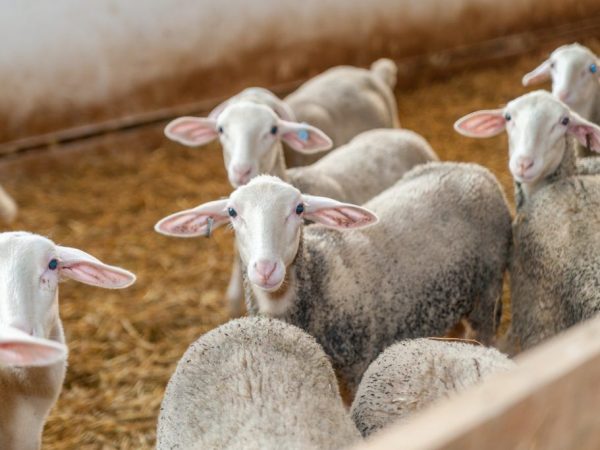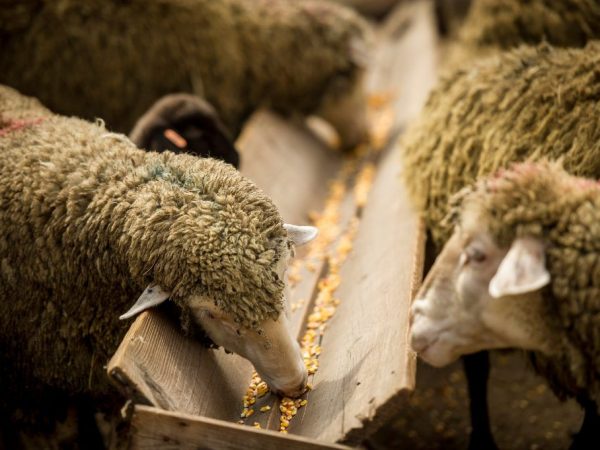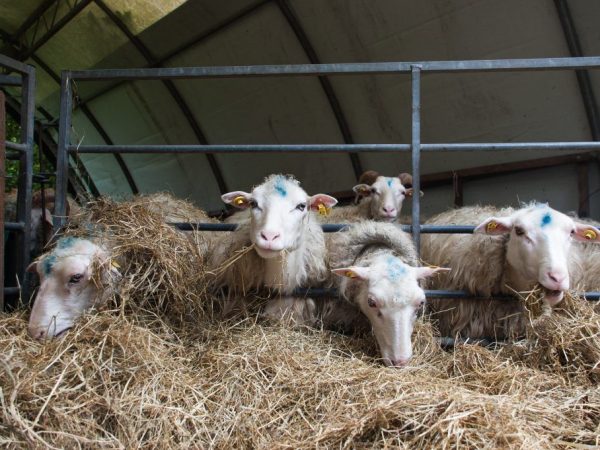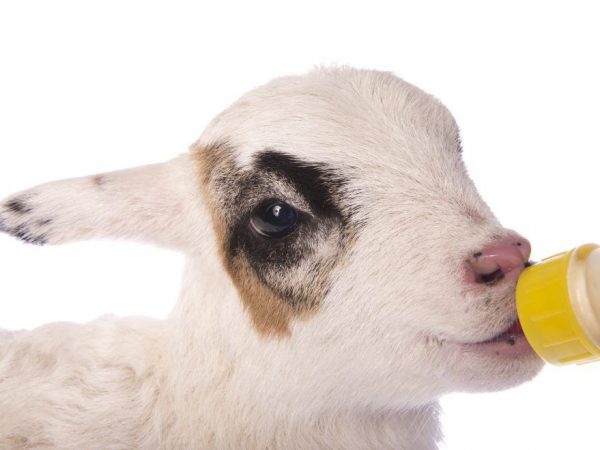Basic rules for feeding sheep
Proper feeding of the sheep can increase the production performance of the animals. Sheep are herbivores, the basis of their food is juicy green food. Sheep breeding is a rather profitable branch of agriculture.

Sheep feeding rules
Digestive system of ruminants
To successfully breed sheep, it is necessary to have some knowledge about the structural and functioning features of their digestive system. The table, which describes the feeding norms of sheep of different ages, helps to choose the right diet.
Sheep are a grazing animal with a high feeding capacity. Their intestines are 30 times their body length. The stomach is multi-chambered.
Compared to other ruminants, sheep are the most effective in using plant feed that grows in the fields. The sheep feeding process is divided into 3 stages:
- mechanical;
- microbial;
- chemical.

Sheep feeding process
The structure of the chewing apparatus allows sheep to pick up individual grains in the field, eat thorny plants, low-stemmed grasses.
It is very important to monitor the normal development of the jaws in sheep. In recent years, there has been an increasing trend in the growth of pathologies in the development of the lower jaw. Such pathologies in dry years can cause mortality in the flock due to malnutrition.
The physiological basis of nutrition is cicatricial digestion. The bulk of the feed eaten by the sheep is broken down by microorganisms in the rumen. Most of the digestible substances are the waste products of those very microorganisms. An excess of protein in the body and a lack of carbohydrates leads to ketonuria, therefore, when fattening, cereals and legumes should be used simultaneously.
Succulent herbs
What can you feed your sheep? The basis of their nutrition is juicy food. Due to the peculiarities of the structure of the chewing apparatus, sheep can be fed not only with juicy green grasses, but also with dead wood, thorns and stubble after harvesting from wheat fields.
The flock cannot be grazed on flood meadows. By the end of summer, the grass loses its nutritional value, so cereals and legumes should be added. Sheep eat silage with special pleasure. In terms of nutritional value, it is only slightly inferior to green forage. It is best to mix corn silage with legumes and roughage.
What do sheep eat during the stable period? Food in the cold season should include root crops: fodder beets and carrots. They have a good effect on the digestive system and enrich the body of animals with all the necessary vitamins and minerals, increasing immunity. It is shown to give up to 4 kg of root crops per day.
In winter, when animals need additional vitamins, pumpkin can be added to the menu. The main product is greens, which allow you to quickly fatten the young in a short period, so special attention should be paid to its quality.All other types of feed are used only as top dressing to enrich the body of sheep with vitamins during the cold season.
Cellulose
In the cold season, the main part of the food is roughage. There are types of feed that are undesirable to give to sheep, for example, straw. However, it is often included in the diet of lambs out of necessity. It is not recommended to exceed the daily dose of 2.5 kg. For young animals, the daily dose is much less - 1 kg, and for the uterus before childbirth - 0.5 kg.

Hay is the most nutritious food
The most nutritious feed during the stall period is hay. It is best to make blanks from flowering herbs. The daily norm for adult lambs is from 2 to 4 kg.
Another type of dry food is haylage. This is a herb, dried in a special way and preserved in jars. The greens are dried by 50%. They begin to make harvesting during haymaking.
Concentrated mixtures
In highly developed countries, sheep are fed with compound feed on large sheep farms. The concentrate contains a full range of vitamins and minerals necessary for the full development of rams and sheep. But the prices for compound feed are sometimes simply exorbitant, and therefore, in our territories, farmers get by with what is in the fields and in the garden.
The concentrated feed contains:
- cereals, represented mainly by wheat, rye, barley and oats;
- legumes;
- sunflower or soybean meal;
- special additives for sheep.
Rationing
Nutritional norms are best determined individually for each individual individual, based on physiological needs and gender. Feeding young animals, young sheep, ewes and rams will differ significantly. The rates are determined taking into account many factors, such as the season and the ultimate goals of the content.
Feeding standards for sheep and young animals in the summer involve free-range keeping. During this period, animals can independently eat as much juicy food as the body needs. At this time, there is a rapid increase in body weight.
With the onset of autumn, there is less succulent feed on pastures and it loses its nutritional properties, so you need to gradually introduce compound feed for sheep and add root crops and silage. In winter, hay is the basis of nutrition, pumpkin, silage, and haylage are additionally introduced. In the cold season, mineral salts must be present in contentment.
Nutrition for adults
A pregnant sheep should receive only the highest quality feed. Approximately four weeks before giving birth, it is recommended to replace part of the roughage in the uterus's diet with juicy ones. In summer, there are no problems with this, and in winter, at least 3 kg of root crops, silage and melons are added to the ration. Straw can be fed up to 0.5 kg per day, concentrated feed should be present in an amount of 300 g.
The nutrition of breeders should be enriched with vitamins and minerals. During mating, the male-producer loses a lot of energy that needs to be restored. To do this, it is necessary to increase the consumption of succulent feed up to 3 kg, and also add up to 1.4 kg of concentrates. For more effective energy recovery, eggs or cottage cheese, vegetables are introduced into the diet of sheep.
After giving birth, the mother needs to be provided with fortified food and clean drinking water in the right amount. Uterus should receive fortified calcium supplements. Without proper nutrition, the full development of the offspring will be impossible, and the lambs may be born with pathologies. Feeding the lambs in the future will depend on how long they stay with the mother.
Feeding the young
What to feed the lambs with? For the first 5 days, babies feed on mother's milk. It so happens that the sheep die during childbirth, then the orphans are fed on their own with cow's milk or put to another uterus. The newborn lamb is bottle fed with a teat 5 times a day.Upon reaching 2 months, the lamb switches to 2 meals a day.

Feeding the lambs
Suckling lambs are kept without supplementation during the first month of life, they receive all the necessary vitamins and minerals along with their mother's milk. Then, along with feeding with milk, solid feed is gradually introduced to the lambs, and later they begin to feed it with dry compound feed, grain, and bread. At 4 months old, the lamb should receive protein-enriched feed.
At the age of 4-6 months at home, the diet of lambs looks like this:
- 0.5 kg of hay, vegetables or juicy greens;
- 300 g of concentrate;
- 150 g of sunflower meal or wheat bran;
- about 4 g of mineral salts.
Feeding for slaughter
The technology of sheep feeding in order to obtain high-quality meat and wool involves the transfer of young animals to special nutrition a couple of weeks before slaughter. The diet should be dominated by carbohydrate feed, mainly clover or leguminous hay, silage is added from juicy feed, about 5 kg per day, as well as vegetables and concentrates. For rapid muscle building, feeds rich in proteins are introduced.
In order for the ram's wool to be silky and shiny, the amount of concentrated feed is increased. Lack of fortified food leads to hair loss, weight loss. Egg and cottage cheese can be added to the ram's diet for full development and rapid weight gain. The lamb gains weight best in the summer, when there is enough green fodder on the pastures. The video describes all the nutritional features of a pedigree ram.
Final part
Balanced feeding of lambs is the key to getting healthy offspring in the future. At home, it is very easy to independently compose the correct diet, especially since you can use the tips from the educational video.
Most often, a sheep brings one lamb to its first offspring. In order for the offspring to develop normally, the diet of the uterus is enriched with vitamins even before mating. The inseminating ram needs to provide sufficient intake of fortified feed for energy recovery.
A couple of weeks before giving birth, they try to replace solid feeds in the uterus's diet with juicy ones and add more concentrates.
In the first month, a sheep feeds lambs at home, and dry feed is introduced in parallel. With mother's milk, babies get their first immunity.
If the sheep refuses the lamb, then the newborn is transferred to artificial feeding. It is better to feed lambs on time, so that in the future there are no problems with the transition to a two-time diet from five meals a day.
The composition of the diet will depend on the season, age of the individual and gender. In the summer months it is mostly grass, in the winter - hay and compound feed with vegetables. Hay and silage practically do not differ from each other in value, therefore, if it is not possible to get silage, you can increase the amount of hay in the diet.
Sheep are usually slaughtered at the age of 7 months. A couple of months before this, they begin active supplementation with protein feed.


